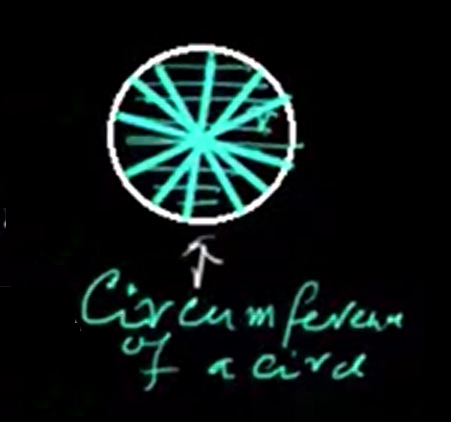The circumference of the circle is the distance around the outside of a circle.
If the radius of the circle is r and diameter is d then,

1) Circumfrence or Perimeter=\(\tt \pi d\)
= \(\tt 2\pi r\) units
2) Circumfrence of a semicircle=\(\tt \frac{1}{2} \times 2\pi r\)
=\(\tt \pi r\)
3) Perimeter of a protracter=\(\tt \pi r\)+ \(\tt 2r\)
=\(\tt (\pi+2)r\)
=\(\tt (\frac{22}{7}+2)r\)
=\(\tt \frac{36}{7}r\)
4) Area of a circle=\(\tt length \times bredth\)
=\(\tt \pi r \times r\)
=\(\tt \pi r^{2}\) sq unit
5) Area of a semi circle =\(\tt \frac{1}{2}\pi r^{2}\) sq unit
6) area of a ring
=Area of the bigger circle - Area of the smaller circle
=\(\tt \pi R^{2}-\pi r^{2}\) sq unit
=\(\tt \pi (R^{2}-r^{2})\) sq unit
=\(\tt \pi (R+r)(R-r)\) sq unit
Illustration:
The diameter of the two circles with centrs A and B are 16 cm and 30 cm respectively. If area of another circle with centre C is equal to the sum of areas of these two circles, find the radius, circumference and area of the circle with centre C.
Solution:
Radius of the circle whose centre is A=8 cm
Radius of the circle whose centre is B=15 cm
Let radius of the circle whose centre is C is r cm
According to question
\(\tt \pi r^{2}=\pi (8)^{2}+\pi (15)^{2}\)
or, \(\tt \pi r^{2}=\pi (8^{2}+15^{2}\)
or, \(\tt r^{2}=(8^{2}+15^{2}\)
or, \(\tt r^{2}=(64+225\)
or, \(\tt r^{2}=289\)
or, \(\tt r^{2}=17^{2}\)
\(\therefore\ r=17\) cm
Circumference=\(\tt 2 \pi r\)
=\(\tt 2 \pi .17\) cm
=\(\tt 2 \pi .17\) cm
=\(\tt 34 \times 3.14\) cm
=\(\tt 106.76\) cm
Area of the circle=\(\tt \pi r^{2}\)
=\(\tt 3.14 \times 289\)
=\(\tt 907.46\) sq cm
Illustration 2:
Two coins of diametrs 6 cm and 8 cm respectively are kept one over the other as shown in the figure. Find area of the part of the lower coin which visible from the top.
Solution:
Area of the ring =\(\tt \pi (R+r)(R-r)\)
Here R is 4 cm & r=3 cm
Area of the visible part of the bigger coin
=\(\tt \pi (R+r)(R-r)\)
=\(\tt \frac{22}{7} (4+3)(4-3)\)
=\(\tt \frac{22}{7} \times 7 \times 1\)
=\(\tt 22\ cm^{2}\)